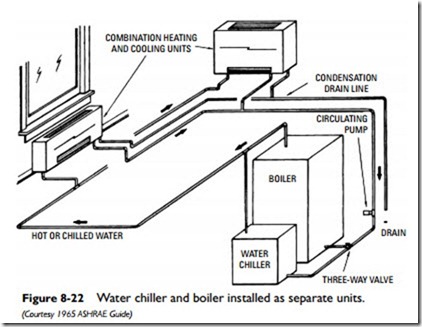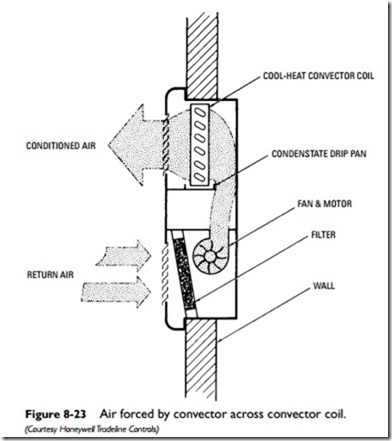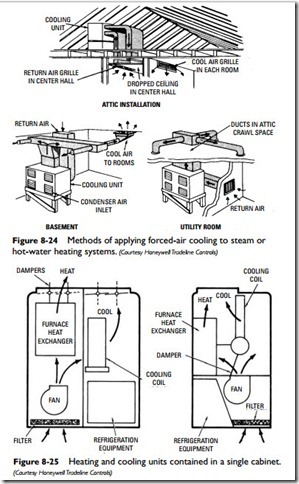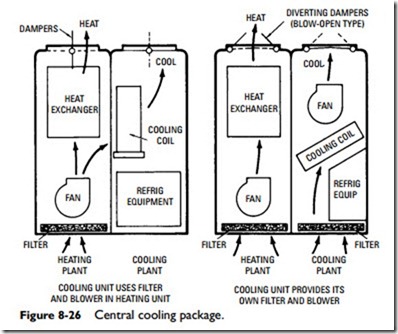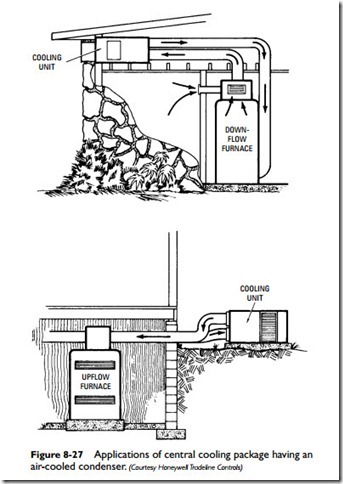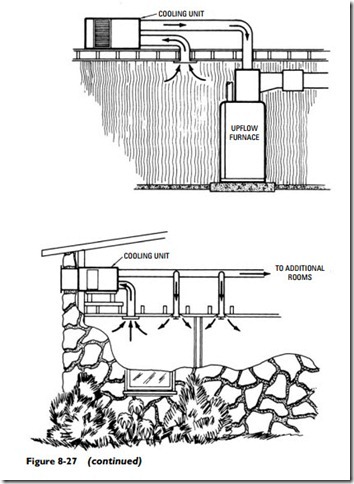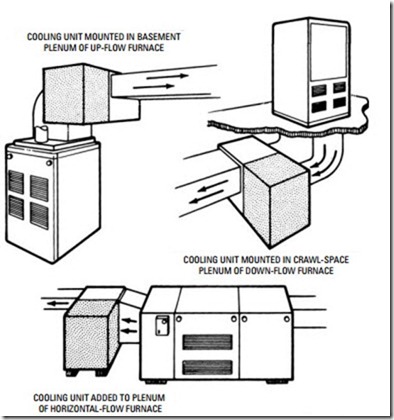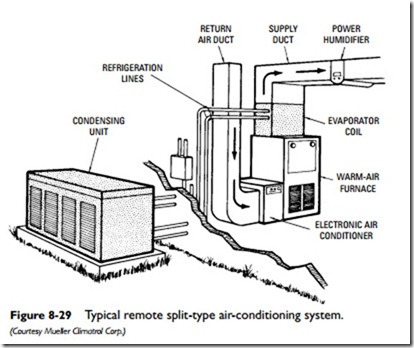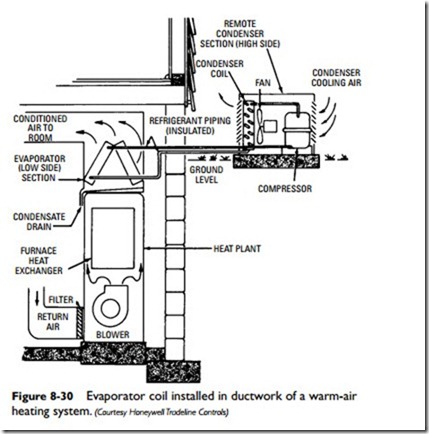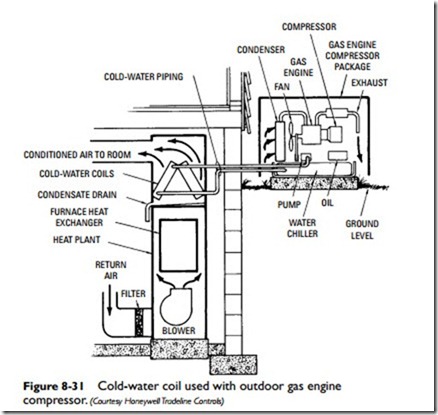Central Air-Conditioning Applications
There are many different ways to apply central air-conditioning to a structure. The method used depends on a number of factors, but the type of heating system is probably the dominant one. The following are the most common types of cooling applications:
1. Water chiller cooling
2. Split-system cooling
3. Year-round air-conditioning
4. Central cooling packages
5. Cooling coils
Water Chiller Cooling
A water chiller is used to add cooling and dehumidification to steam or hot-water heating systems. A refrigeration-type water chiller consists of a compressor, condenser, thermal expansion valve, and evaporator coil. The water is cooled in the evaporator coil and pumped through the system.
A typical system in which a water chiller is used is shown in Figure 8-22. The boiler and water chiller are installed as separate units, each with its own circulator (pump), or with one circulator in the return line. Hot water from the boiler is circulated through the
convectors for heating, and cold water is circulated through the same piping from the water chiller for cooling purposes.
Each convector unit contains a blower to force the air across the convector coil (see Figure 8-23). Water condensed from the coil during the cooling operation is trapped in a drip pan and discarded through a drain connected to the convector. Some convectors also contain a filter for air cleaning. The room convectors in a water chiller cooling system are usually designed for individual control.
The same piping carries both the chilled and hot water to the room convectors, but it must be insulated to minimize condensation during the cooling operation.
Water chillers are available as separate units or as a part of a complete package containing the boiler. Separate water chiller units are used when cooling must be applied to an existing steam or hot water heating system.
Split-System Cooling
Another method of applying central air-conditioning to a steam or
hot-water heating system is to add forced-air cooling. This type of cooling application is sometimes referred to as a split-system instal- lation—that is to say, a system split or divided between one type of heating (conventional steam or hot water) and another type of
cooling (forced air). This results in some confusion because the term split system is also used to refer to the separation of components in a year-round central air-conditioning system using forced warm-air heating and cooling (see Location of Equipment).
Three typical methods of applying forced-air cooling to a steam or hot-water heating system are shown in Figure 8-24.
Year-Round Air-Conditioning
In a year-round air-conditioning system, the heating and cooling units are combined in a single cabinet (see Figure 8-25). This combined package heats, cools, humidifies, dehumidifies, and filters the air in the structure as required. The unit may have an air-cooled, a water-cooled, or an evaporative-type condenser. The arrangement of the ductwork will depend in part on the type of condenser used in the unit.
Central Cooling Packages
A central cooling package is a unit designed for central air-conditioning applications. It consists of a cooling coil and the refrigeration equipment and will provide the necessary cooling and dehumidification as conditions require. These units are available with their own fans and filters, or they may be installed to use the filter and blower of the existing heating equipment (see Figure 8-26).
The method used to install a central cooling package will depend on whether the unit has an air-cooled or water-cooled condenser. If an air-cooled condenser is used, provisions must be made to carry outdoor air to and away from the condenser. Typical installations in which an air-cooled condenser is used are shown in Figure 8-27. Figure 8-28 illustrates some typical methods of applying a central cooling package in which a water-cooled condenser is used.
A typical remote or split system is shown in Figure 8-29. In this installation, the compressor and air-cooled condenser unit are located outdoors. The evaporator coil, fan, and heating appliance are located indoors in the conditioned space.
Cooling Coils
Cooling can be applied to a warm-air heating system by installing an evaporator coil or a cold-water coil in the ductwork. The evaporator coil is the low-side section of a mechanical refrigeration sys- tem. As shown in Figure 8-30, the evaporator coil is installed in the ductwork above the furnace. It is connected by refrigerant piping to the condenser coil and compressor installed outdoors.
A thermostatic expansion valve and condensation drip pan (with drain) are included with the evaporator coil. Sometimes a fan is added to the coil to supplement the furnace blower.
A cold-water coil may be used instead of an evaporator coil in the ductwork. Cold water is supplied to the coil by a water chiller,
which can be located in the basement, a utility room, or outdoors. If the water chiller is installed outdoors, a gas engine can be used to drive the compressor (see Figure 8-31).
Hydronic Forced-Air Systems
In a hydronic forced-air system, the water is first heated in a boiler (sometimes called a hydronic furnace in these systems) or water heater and then circulated through the coils of a liquid-to-air heat exchanger connected to the furnace air handler. Heat is transferred from the water in the coils to the air inside the air-handler compartment. A blower forces the warm air through ducts to outlets inside the rooms. Cool air is produced by a chilled water or DX coil inside or on top of the blower cabinet. The cool air is distributed by the blower through the same ductwork used by the warm air. Condensation is collected by a condensate pump.
Hybrid Systems
A hybrid heating and cooling system consists of a radiant hydronic heating system working in conjunction with a separate cooling sys- tem. Hot water is produced by a hydronic boiler, water heater, or combination water heater. The cooling system is added to an existing
hydronic system, when augmenting or upgrading the mechanical sys- tem of an older house or building. Some of the systems used to pro- vide cool air to an existing hydronic heating system are described in the following paragraphs.
Indirect/Direct Evaporative Coolers
A high-efficiency indirect/direct evaporative cooler designed with a hydronic option can be used to supply cool air to a house with an existing hydronic heating system. The evaporative cooler has a Seasonal Energy Efficiency Ratio (SEER) of 36, which is three times the minimum SEER efficiency rating for air conditioners. Air cooled by direct and indirect evaporation can generate approximately the same amount of cooling as a 3-ton air conditioner. The cool air is delivered directly to the interior of the house or through a short duct.
Ductless Split System
As the name suggests, the ductless split system does not require duct- work. The system consists of an indoor air handler and an outdoor condenser, connected by refrigerant tubing extending through a 3-inch hole in the wall. Decorative units can be mounted on the floor, wall, ceiling or recessed (drop) ceiling. The system can consist of a single zone with one condenser and one air handler, or a multizone system with one condenser containing two or more compressors connected to one, three, or four air handlers. The ductless split system is capable of producing 9000 Btu to 48,000 Btu, depending on the application.
Fan Coil and Flexible Ducts
The conditioned air is produced by a fan coil located in the attic, an attic crawl space, the basement, or a closet. If the air-conditioning unit is placed in the attic or an attic crawl space, a 5-ton one is small enough to insert between 16-inch on centers ceiling joists without cutting any framing. The distribution system consists of flexible 2-inch-diameter tubing running inside walls and floors and around internal framing obstructions. The conditioned air is delivered to the rooms through a 2-inch opening in the ceiling.
Residential Chiller with Ceiling-Mounted Panels
Chilled water is run through ceiling-mounted panels that exchange heat with the warm air in the room. The heated water is then carried down to the chiller where it is again cooled and returned to the ceiling. The system uses small ducts to feed fresh air directly into the house or building.
Room Air Conditioners
Room air conditioners are designed to cool a single room or space in a structure. The most commonly used type of room air conditioner is the window-mounted unit. These air conditioners are available for installation in single-hung windows, double-hung windows, horizontal sliding windows, and casement windows. Make sure to read carefully the specifications printed on the shipping container before purchasing a window air conditioner. The specifications should list the air conditioner’s dimensions, the type of window installation, and its Btu output. Room air conditioners are also available for through-the-wall installation in exterior walls. A sleeve is provided for the wall mounting.
Related posts:
Incoming search terms:
- application of central air conditioning
- 41 Air Conditioning Equipment
- structure of central air conditioning unit
- refrigeration machinery rooms air ducting system
- hvac system types uses & application
- centre air conditions applicatio&use
- central air-conditioning application
- central air conditioning system
- central air conditioner dimensions
- Central AC applicatons
- applications of air conditioning
- application area of air conditioning system
- year around air conditioning system
